Robert Cahen
Sculpting Time
17.1. —
16.3.2008





Kunsthaus Baselland is the venue of the first solo show in Switzerland devoted to Robert Cahen, who ranks among the most popular French video artists. Born in Valence in 1945, Cahen now lives in Mulhouse, after having traveled extensively.
He graduated from the Conservatoire National Supérieur de Musique in Paris in 1971. The two factors that have most lastingly impinged on his experimentation with electronic images and sounds are his keen interest in contemporary music and his work for ORTF, the National French radio and television broadcasting corporation.
In addition to audiovisual projects in which sound and images are organized, transformed, and processed on an equal footing, he has also shot videos since 1973 that, while being based on electronic sound experiments, operate only visually. Cahen’s videos are marked by his unique manner of handling time and the various modes of presenting temporal dimensions. “We no longer see the time of chronos, a linear sequence of identical units of time. Rather, we perceive changes in time brought about by time as motions of transformation, expressed in never-ending loops of appearances and disappearances.” (P.M. Meyer) Cahen’s videos expose no references to the past and the future, but images are created and fade away, they blend into each other and ‘come into being’ thanks to motion. Hence, Cahen’s works are moving pictures rather than films.
The exhibition spans the period from 1995 to 2007 and presents five video installations. It focuses on humans and landscapes. Sanaa, passages en noir (2007) centers on a single place, an alleyway somewhere in the capital city of Yemen. Neither the time of day nor the view of the narrow lane changes. And yet people come and go, primarily women elaborately wrapped in layers of clothing who appear and vanish just as quickly in one of the houses, merging with their own shadows or passing by individual men. There is no interaction. Each person exists independently, isolated from all others by their garments. This film, one of the few in Cahen’s body of work that features sound, is accompanied by Bach’s St. John Passion, which conjures up suffering, the sensation of remaining anonymous, and the notion of disappearing women, a stand-in of sorts for the failure of humanity in general. Cahen’s video Traverses from 2002 also articulates the processes of becoming, disintegrating, surfacing, vanishing, being, and fading away. Modeled on high-format tableaux, this work has people appear and disappear in a veil of mist. Cahen acts like a sculptor who carves people out of the foggy mass. The term “Sculpting Time”, a time detached from its surrounding matter that lets us catch glimpses of what it hides for a specific period, is an apt description of this activity. In Suaire (1997) two projectors project images onto a hanging and slightly billowing fabric. Pebbles underneath the installation convert each step into an acoustic signal: Every step becomes a manifestation of the moment, and likewise every image can be seen only briefly on the moving fabric. Suaire, a formal reference to the Christian Veil of Veronica (sudarium), addresses the transition between life and death, between the image fading away and the memory of what has happened.
Cercle (2005) is a polar landscape dotted with icebergs. The flow of the ocean changes its direction again and again, resulting in an almost circular motion. Cahen’s imagery oscillates between realism and alienation, between a rhythmic cadence and abrupt changes of scenes. His films follow no narrative continuity. Rather, in their repetitiveness, variation, rhythm, and deceleration they engender a “time window” or a “window of consciousness” (E. Husserl).
Cahen’s videos offer images of traveling, of very different passages of life, and of transitions between the past and the present. To put it very succinctly, they translate and trigger emotions.
Text by Sabine Schaschl